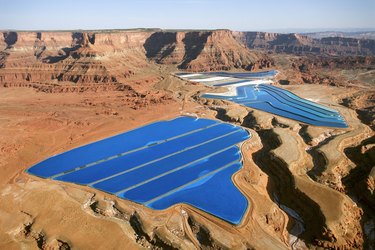
Potassium permanganate is an oxidant, but a poor disinfectant. It's often used in well water to control odor and taste, remove manganese, iron and color from the water, and to control biological growth that is considered a "nuisance," such as the Asiatic clam, according to the Environmental Protection Agency. The substance is most often used as a pre-treatment before water is filtered, and is better at removing sulfide odors from water than chlorine.
Step 1
Determine the water's temperature, pH, and manganese and iron levels with a water sample test. You can tell if the levels of manganese are high visually, as the water will have a pink tint. The potassium permanganate dose needed for oxidation is 0.94mg per milligram of iron and 1.92mg per milligram of manganese. Rates of oxidation will depend on the pH. Iron oxidation can occur within 10 minutes if the pH is 7.2 or more, but can require an hour if the pH is 6.9, according to the University of Iowa. Manganese oxidation will be slower. It requires less than one hour only at a pH of 9.5 or above. You may need a detention tank to give adequate time for iron and manganese to oxidize. If you are treating taste and odor, use doses of potassium permanganate ranging from 0.25 to 20mg per liter according to the manufacturer's instructions.
Video of the Day
Step 2
Purchase pre-made tablets of potassium permanganate if you do not want to do your own calculations. Follow the manufacturer's instructions. For example, one product advises using one tablet per 50 gallons of water, but dropping back to one tablet per 100 gallons if you just want to improve water clarity, such as in a pond. The manufacturer advises using two tablets per 50 gallons of water to treat bacterial and parasite problems. Tablets are sometimes found at garden and camping supply stores, as well as online (see Resources below).
Step 3
Filter drinking water to remove the manganese dioxide as well as the elemental sulfur precipitate that resulted from the treatment with the potassium permanganate. Potassium permanganate treatment is commonly paired with a "greensand" resin bed system. It's best to have your filter professionally installed, advises The American Ground Water Trust, because water quality problems often do not have straightforward solutions. Also get a written contract from the installer, the Trust advises.
Step 4
Store your potassium permanganate in a cool, dry area, advises the Carus Corporation. Keep it in a closed container. Also ensure it does not come into contact with peroxides or acids. Any combustible organic or readily-oxidizable materials should also be kept apart from the substance because it will support combustion, according to Carus.
Things You'll Need
Safety goggles
Face shield
Dust mas
Coveralls
Impervious gloves
Boots
Water sample test
Filtration system
Cool, dry storage area
Warning
Use caution when handling potassium permanganate crystals, which will be a dark purple or black in color and have the chemical composition KMnO4. Use safety goggles, a face shield and a dust mask. Also, wear coveralls, impervious gloves and boots to keep skin contact to a minimum. Potassium permanganate can cause skin irritation, irritation internally if inhaled, serious eye injury, and may be fatal if swallowed, according to the EPA.
Video of the Day